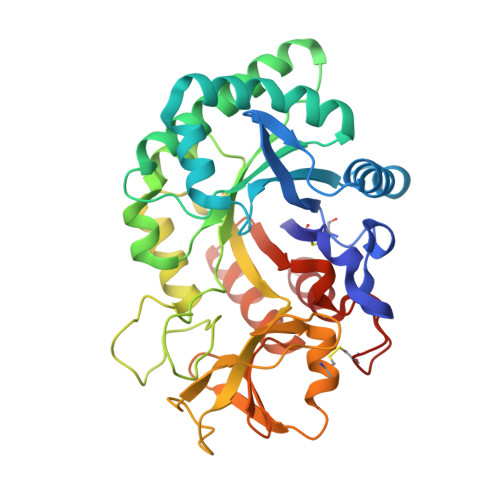Carbohydrate-binding properties of goat secretory glycoprotein (SPG-40) and its functional implications: structures of the native glycoprotein and its four complexes with chitin-like oligosaccharides
Kumar, J., Ethayathulla, A.S., Srivastava, D.B., Singh, N., Sharma, S., Kaur, P., Srinivasan, A., Singh, T.P.(2007) Acta Crystallogr D Biol Crystallogr 63: 437-446
- PubMed: 17372347
- DOI: https://doi.org/10.1107/S0907444907001631
- Primary Citation of Related Structures:
2DSZ, 2DT0, 2DT1, 2DT2, 2DT3 - PubMed Abstract:
A 40 kDa glycoprotein (SPG-40) secreted during involution works as a protective signalling factor through its binding to viable cells. The crystal structure of the native protein has been determined at 2.3 A resolution. This is the first report on the carbohydrate-binding properties of SPG-40; the structure determinations of the complexes of SPG-40 with four oligosaccharides of different lengths at resolutions ranging from 2.2 to 2.8 A are described. Carbohydrate-binding studies with N-acetylglucosamines (GlcNAc(n), n = 3-6) using fluorescence spectroscopy revealed poor binding effects with GlcNAc(3) and GlcNAc(4), while GlcNAc(5) and GlcNAc(6) bound to SPG-40 with considerable strength; the dissociation constants (K(d)) were estimated to be 260 +/- 3 and 18 +/- 4 microM, respectively. SPG-40 was cocrystallized with GlcNAc(3), GlcNAc(4), GlcNAc(5) and GlcNAc(6). The overall structure of native SPG-40 was essentially similar to that reported previously at low resolution. The structures of its complexes with GlcNAc(3), GlcNAc(4), GlcNAc(5) and GlcNAc(6) revealed the positions of these oligosaccharides in the carbohydrate-binding groove and provided insights into the mechanism of binding of oligosaccharides to SPG-40, indicating that the preferred subsites in the carbohydrate-binding groove of SPG-40 were from -4 to -2. The structure of the protein remained unperturbed upon binding of GlcNAc(3) and GlcNAc(4), but the structure changed significantly upon binding of GlcNAc(5) and GlcNAc(6). Significant conformational variations were observed in the sugar-binding groove: Trp78 partially flipped out of the barrel in GlcNAc(5), while in the GlcNAc(6) complex a completely flipped-out Trp78 was observed along with several other conformational changes, including those of Asp186 and Arg242. Such changes upon binding to carbohydrates have not previously been observed in chitin-hydrolyzing chitinases and reflect less favourable binding of carbohydrates to SPG-40. As this appears to essentially be a binding protein, this loss of binding affinity might be compensated by other intermolecular interactions such as protein-protein interactions and also by the binding of its own glycan chain.
Organizational Affiliation:
Department of Biophysics, All India Institute of Medical Sciences, New Delhi 110029, India.















